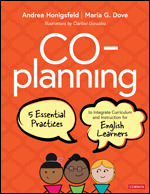Co-Planning
Five Essential Practices to Integrate Curriculum and Instruction for English Learners
Illustrated by Claribel González
English Learners (ELs) and multilingual learners (MLs) have double the work of their English-speaking peers as they are required to master language and content simultaneously. To support this dynamic academic and language development process, all teachers need to have an understanding of language acquisition and EL/ML-specific methodologies along with offering social-emotional support to ELs/MLs and work in tandem with each other.
Bestselling authors Andrea Honigsfeld and Maria G. Dove have returned with this new resource that complements and expands on their previous titles on co-teaching and collaboration by addressing collaborative planning in greater depth. Co-planning is positioned as the first step toward integrative language and content instruction as regular and purposeful collaboration ensures that Els/MLs have access to core content.
Key features include:
• Practical, step-by-step guidance to starting and sustaining collaborative planning for integrated language, literacy, and social-emotional development
• An array of checklists, templates, and protocols for immediate implementation
• Snapshots from the Field provide real-life examples of co-planning in action
• Beautiful full-color design with original sketch notes to bring concepts to life
• QR codes that link to author interviews elaborating on key ideas
This substantial guide will assist novice and seasoned educators alike in their move away from isolated practices and help them engage in collaborative planning and professional dialogue about asset-based, best practices for ELs/MLs.
Supplements
"When Andrea and Maria shared that they were coming out with this book, they had me at co-planning. My practice has been transformed with their other books on co-teaching and teacher collaboration, and this newest book continues their advocacy for multilinguals through teacher collaboration. Just like their other resources, this book is practical, researched-based, and guided by practice. They share frameworks, structures, and processes for making the best of co-planning. With this book, they have lifted co-planning to its essential role in the co-teaching model."
Co-planning can significantly elevate instruction, support teacher learning and development, and change the learning experiences for multilingual learners. Yet, there has long been a need for co-planning resources that are practical, research-based, and easy to implement. Honigsfeld and Dove fill that need as they share five essential components for effective collaborative planning with extensive classroom examples and ready-to-use resources.
"Co-Planning offers an exciting and much-needed addition to the groundbreaking work Andrea Honigsfeld and Maria Dove already done in the field of educating ELs/MLs. It is evident that they understand what teachers need to make collaboration successful. Throughout the book the authors use real-life examples from teachers who are doing the work in classrooms. The examples are relevant, current, and practical.
This guidebook will support efforts in leading a school faculty and staff towards a collaborative culture centered in equity, diversity, and inclusion. In addition to the research-based approaches for supporting culturally and linguistically diverse students, this book includes engaging graphics, useful checklists and planning resources, and an overall easy-to-read format. There are plenty of ideas to take to co-planning teams right away.
If you are an administrator, you’ll appreciate the structured and direct approach from these trusted experts. If you are a teacher reading the book, it will feel like you’re learning from a valued colleague. If you’re just getting started or have some co-teaching under your belt, this resource offers plenty of ideas for actionable next steps.
This is truly a delight to read!"
"Co-Planning helps teachers move from isolation to collaboration to co-plan impactful lessons for MLs, and all students! The essential concepts and practical tools are relevant to ALL educators committed to deepening equitable access in linguistically-rich schools."
"While many leaders supporting ELs and MLs appreciate the imperative to integrate grade level content, literacy, and academic English in all subjects, few understand how to do it. Co-Planning: Five Essential Practices to Integrate Curriculum and Instruction for English Learners not only makes this crystal clear, but also provides leaders with critical resources for professional learning to support school and district improvement plans for all students. Leaders will quickly recognize the intersection of the practices in this book with the Professional Standards for Educational Leaders, The 6 Principles for Exemplary of Teaching of English Learners, and the synthesis of educational leadership research presented in the Wallace Foundation report, How Principals Affect Students and Schools. Every educational leader needs this book!"
"Honigsfeld and Dove are THE experts on co-teaching and co-planning and this new book presents a deeper dive into co-planning, focusing on 'the HOW:' how to make collaboration happen and how to make collaboration impactful. The stunning visuals throughout the text increase engagement, promote deeper understanding, and model a relevant, research-supported strategy. The sample co-planning and co-teaching schedules are terrific tools to use when advocating with administrators. They help administrators see the possibility of making co-teaching happen within existing staffing realities. The reflection questions and action steps, included at the end of each chapter, are tools that help educators prepare to take immediate action. Teachers: get your book club ready; gear up your PLC! This book is exactly what you have been looking for to help you make co-teaching your reality."
